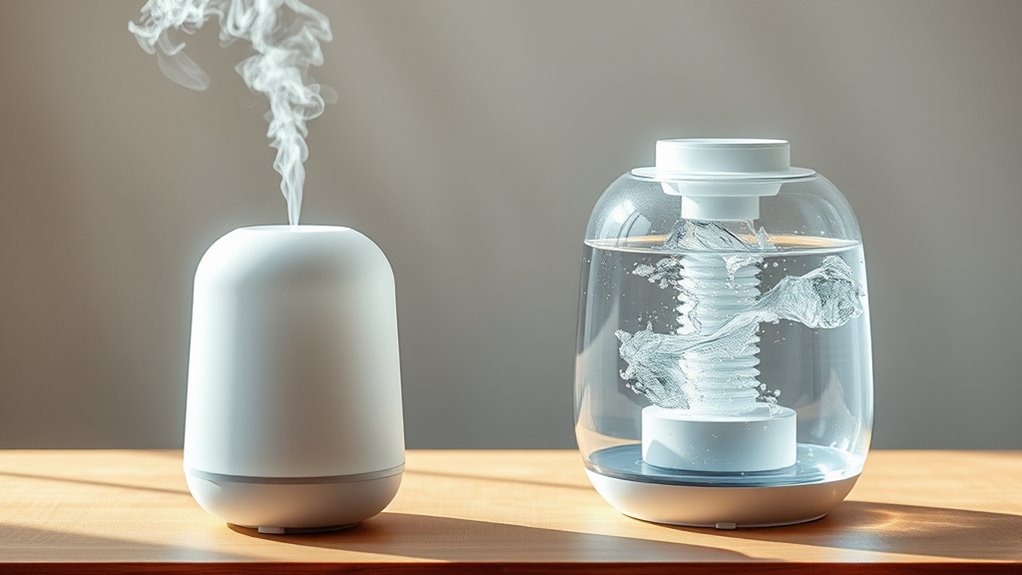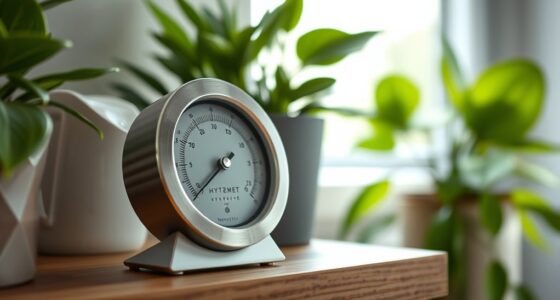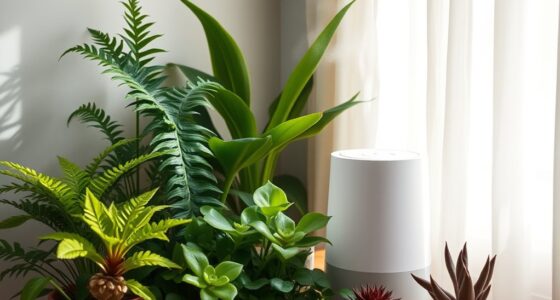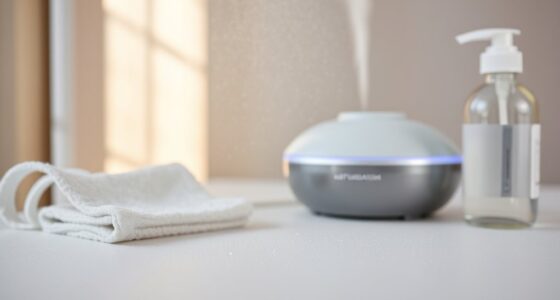A humidifier adds moisture to your indoor air by releasing vapor, helping with dry skin and breathing issues. An air washer not only humidifies but also filters out dust, pollen, and allergens, improving your air quality. While humidifiers mainly focus on increasing humidity, air washers combine humidity control with air cleanliness. To understand which suits your needs better and how regular maintenance plays a role, keep exploring the details below.
Key Takeaways
- Humidifiers primarily add moisture to indoor air, while air washers both humidify and filter airborne particles.
- Air washers improve air quality by removing dust, pollen, and allergens, unlike humidifiers that mainly increase humidity.
- Humidifiers require regular cleaning to prevent mold and bacteria buildup; air washers also need frequent maintenance of filters and components.
- Humidifiers help with dry skin and respiratory issues, whereas air washers are better for allergy sufferers due to particle removal.
- Choosing depends on whether you need simple humidity enhancement or combined humidity control and air purification.
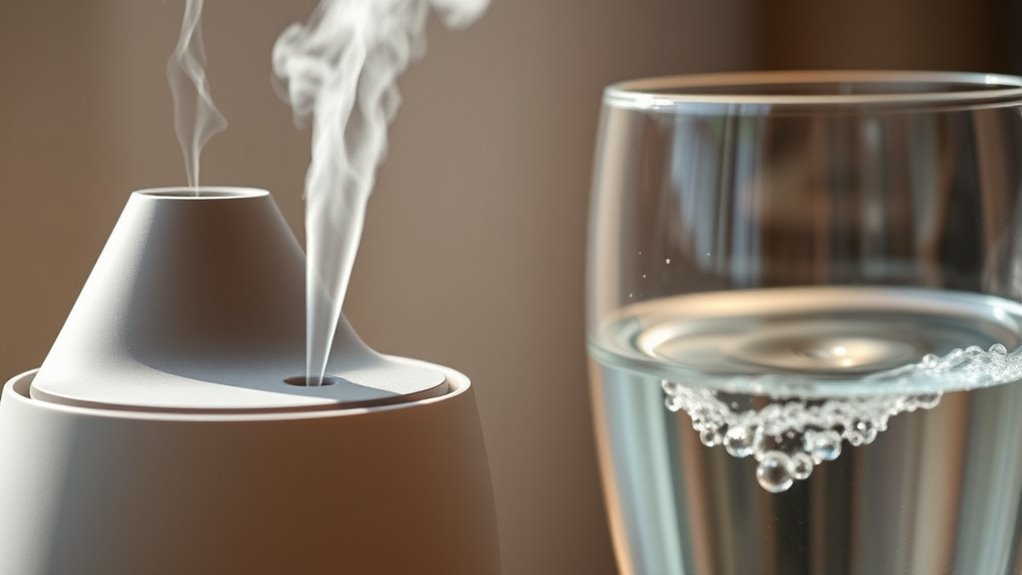
When choosing between a humidifier and an air washer, it’s important to understand how each device affects your indoor air quality. Both help improve comfort, but they do so in different ways, and their impact on air quality varies. A humidifier primarily adds moisture to the air, which can help ease dry skin, irritated sinuses, and respiratory issues. An air washer, on the other hand, not only adds humidity but also filters out airborne particles, dust, and allergens, improving overall air purity. Knowing the differences can help you decide which device better suits your needs, especially considering factors like air quality and maintenance requirements.
With a humidifier, your main concern is moisture levels. It’s straightforward: you fill it with water, and it releases vapor into the room. However, the air quality benefit depends on proper maintenance. If you don’t clean your humidifier regularly, it can become a breeding ground for mold, bacteria, and mineral deposits, which can then be dispersed into your indoor air. This not only reduces the device’s effectiveness but may also compromise your health. Maintenance requirements for humidifiers involve daily cleaning, regular changing of water, and occasional descaling, especially in areas with hard water. Failure to keep up with cleaning can lead to poor air quality, making the device counterproductive. proper maintenance is essential to ensure both devices function effectively and safely.
An air washer combines humidity control with air filtration. It typically uses a rotating drum or a series of plates, along with water, to trap airborne particles as the air passes through the device. This dual function means it can markedly improve air quality by removing dust, pollen, pet dander, and other allergens, making it ideal for allergy sufferers or households with pets. However, because it relies on water to trap particles, it also demands regular maintenance. You’ll need to clean the water basin frequently to prevent mold and bacteria growth. The filters or washer components must also be checked and cleaned according to the manufacturer’s instructions to ensure top performance. Proper maintenance is essential, or else the device’s ability to improve air quality diminishes, and it may even become a source of pollutants if neglected.
Frequently Asked Questions
Can Both Devices Be Used Simultaneously in One Room?
You can use both devices simultaneously in one room, as they offer dual functionality and can complement each other. Just make certain device compatibility and follow manufacturer instructions to prevent over-humidifying or moisture buildup. Using a humidifier and an air washer together can improve air quality and humidity levels effectively. However, monitor the room’s conditions closely to avoid issues like mold or excessive moisture.
Which Device Is More Energy-Efficient?
Think of energy efficiency as a dancer’s grace—smooth and effortless. When choosing between a humidifier and an air washer, you’ll find the air washer generally uses less energy, making it more power-efficient. It’s like a well-choreographed routine that conserves energy while doing its job. So, for lower energy consumption, the air washer takes the spotlight, helping you save power without sacrificing air quality.
Do Air Washers Remove Dust and Allergens Effectively?
You might wonder if air washers effectively remove dust and allergens to improve your air quality. They do a good job by trapping larger particles and some allergens through their filtering process. However, regular maintenance tasks like cleaning the filters and water basin are essential to keep them working efficiently. While they enhance air quality, for smaller allergen particles, consider additional air purifiers for ideal results.
Are There Specific Room Sizes Best Suited for Each Device?
You might think certain devices suit all room sizes, but that’s not entirely true. Smaller rooms benefit from compact air washers or humidifiers that efficiently manage humidity without overwhelming the space. Larger rooms require more powerful units with higher capacity for effective air quality. To choose the best device, consider your room size and specific needs, ensuring your device’s capacity matches the space for ideal air purification and comfort.
How Often Do Filters or Water Need Replacing?
You should check your filter lifespan regularly, typically every 1 to 3 months, depending on usage and water quality. For water replacement, follow a consistent water replacement schedule, usually every 24 to 48 hours, especially in humidifiers. This helps prevent mold and bacteria growth. Keeping up with these routines guarantees your device runs efficiently, maintains air quality, and lasts longer.
Conclusion
So, whether you’re looking to add moisture, remove impurities, or improve air quality, understanding the differences helps you make the right choice. A humidifier adds moisture, a purifier cleans the air, and an air washer does both. Decide what your space needs—moisture, cleanliness, or both. Choose what fits your lifestyle, your environment, your needs. Because in the end, it’s about creating a healthier, more comfortable space—one breath at a time.
